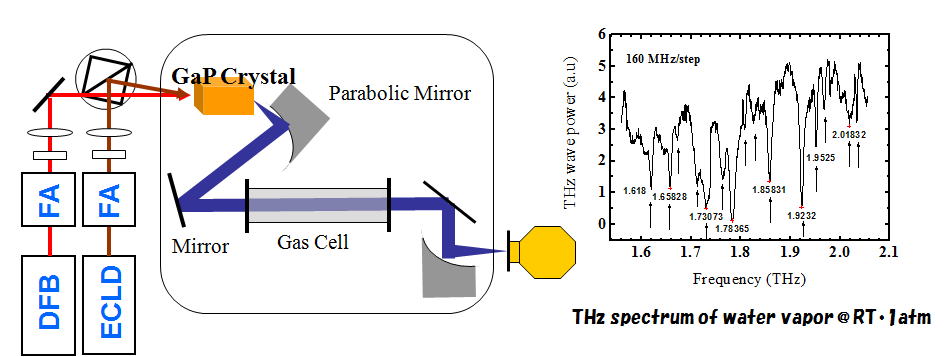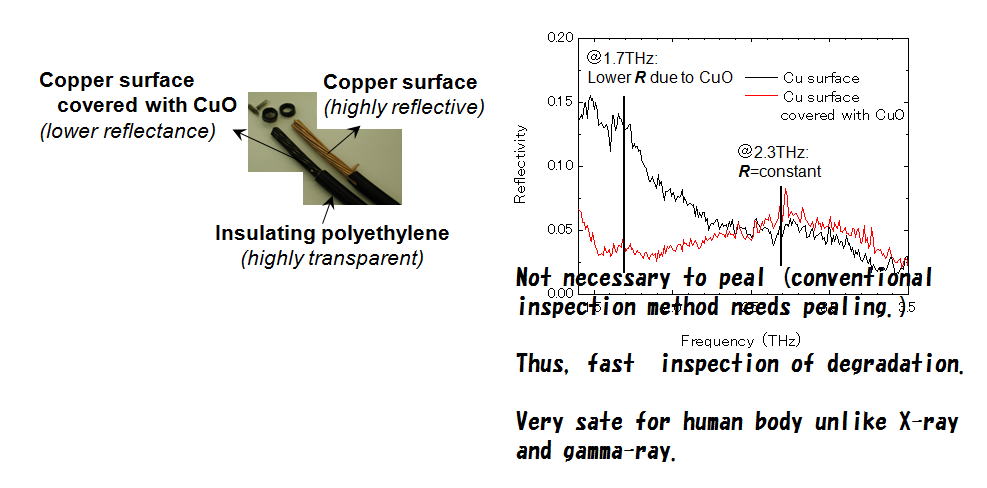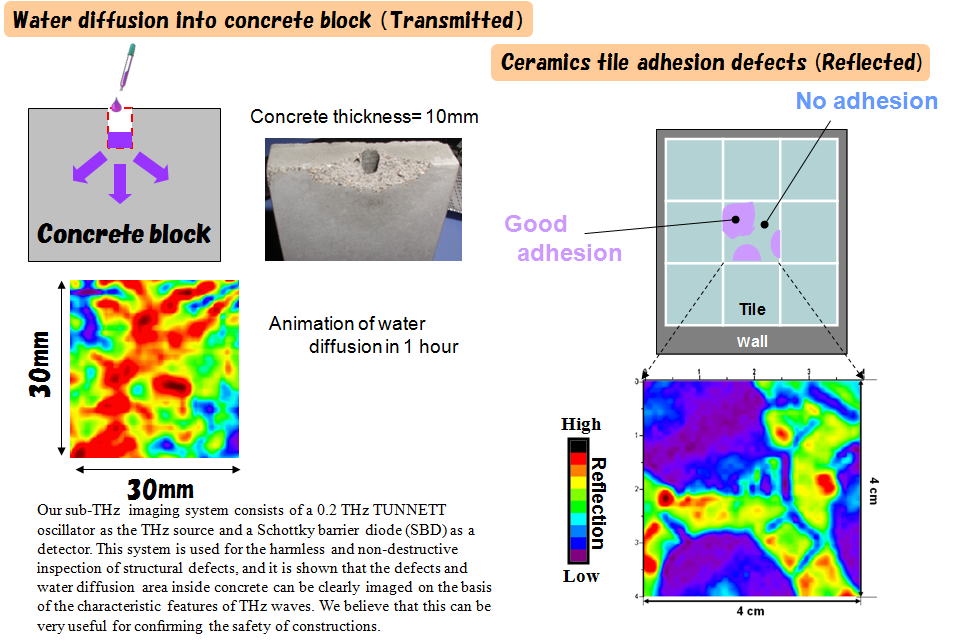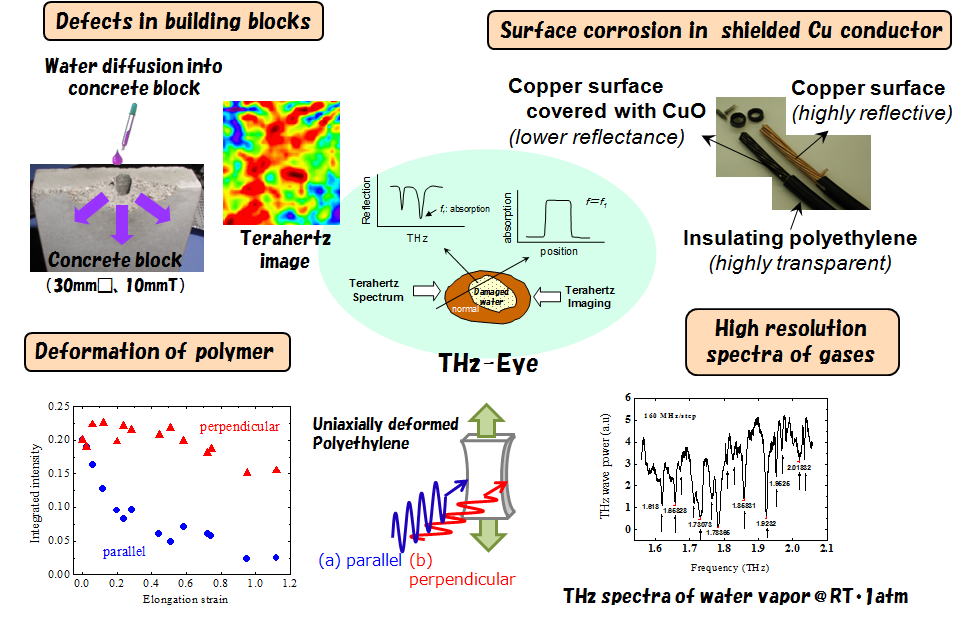We have developed a continuous wave (CW) THz wave generation by near infrared
laser diode
(NIR-LD) pumping based on non-collinear phase-matched difference frequency generation
(DFG) in a GaP crystal. By using this generator, we measured spectra of water vapor and
deformed polyethylene plates with high resolution. The linewidth of generated THz wave is
about 4 MHz. So the
frequency quality factor Q is up to 106. THz power can be increased
(i) in proportion to the square of crystal length and (ii) in inverse proportion
to the NIR beams
cross-sectional area. The merit of the system is wide frequency tunability with a linewidth of a
few MHz. THz waves were tuned very smoothly over a frequency range of 0.67-4.46
THz.

�n糌��� �c糋��� ���R�T ��������
�uGaP�R�q�[�����g�e���w���c�Ό���������ɂ��|���G�`�����̕ό`�E����v
���{�����w� 74 (2010) 149-152.
T. Tanabe, K. Watanabe, Y. Oyama, K. Seo
�gPolarization sensitive THz absorption spectroscopy for the evaluation
of uniaxially deformed ultra-high molecular
weight polyethylene�hNDT & E
International 43 (2010) 329-333.
T. Tanabe, Y. Oyama, K. Nakajima, K. Shinozaki, Y. Nishiuchi
�gNon-destructive evaluation of corroded metal surface by
using terahertz wave - a killer application of THz wave -�h
The International Workshop on Terahertz Technology 2009,
Nov 30-Dec 3, 2009, Osaka University, Osaka, Japan
Y. Oyama, L. Zhen, T. Tanabe, M. Kagaya
�gSub-Terahertz Imaging of Defects in Building Blocks�hNDT & E International 42 (2009) 28-33.
Mechanically extensional-deformation of ultra-high molecular weight polyethylene
(UHMWPE) was examined by using polarization THz spectroscopy as well as
X-ray
diffraction (XRD) analysis. Due to the B1u lattice translational mode, a THz absorption
band was observed around 2.2 THz. The band intensity of the non-deformed
UHMWPE is
isotropic. For deformed UHMWPE, the dichroism appeared in the 2.2 THz band.
The
absorption intensity was smaller in spectra in which the THz wave electric polarization
direction was parallel to the deformation direction than that in which
the polarization was
perpendicular. The intensities in each polarization direction are dependent
on the amount of
elongation strain. Based on influences drawn from the THz and XRD results, THz
nondestructive diagnosis of the tensile strain in deformed UHMWPE is proposed
based on
the dichroism of B1u band
intensities observed in polarization THz spectroscopy.
We have discovered that very thin surface oxide
layer shows serious effects on THz reflection
intensity at a specific frequency even when layer
thickness is very thin compared with the wavelength
of THz wave. This phenomenon contributes to
detect the corroded surface of metals for
non-destructive evaluation of corrosion. To realize
such an evaluation, terahertz wave is the best, due
to its high permeability for insulators and sensitive
change of reflection intensity from metal surface
covered with insulators. We have performed the
THz diagnosis for copper conductors covered with
insulating polyethylene. The reflection spectra from
non-corroded copper and copper with corroded
oxide layer were different from each other. The
reflectivity from copper with corroded oxide layer
around 1.7 THz is smaller than that from
non-corroded copper. The difference of THz
reflectivity from coppers can be ascribed based on
Drude�fs principle. This study becomes one of the
killer applications for terahertz wave and
contributes greatly in the field of non-destructive
evaluation for corroded metals.
THz wave can be used for non-destructive &
in-line inspection of surface corrosion in
shielded Cu conductor. It is effective for
prevention of unexpected breakdown of
electrical power line. It is not necessary to
peal. Conventional inspection method needs
pealing. Thus, fast inspection of degradation
is realized. It is very safe for human body
unlike X-ray and gamma-ray.
Our sub-THz
imaging system consists of a 0.2 THz TUNNETT oscillator as the THz source
and
a Schottky barrier diode (SBD) as a detector. This system is used for the harmless
and
non-destructive inspection of structural defects, and it is shown that
the defects and water diffusion
area inside concrete can be clearly imaged on the basis of the characteristic
features of THz waves.
We believe that this can be very useful for con?rming the safety of
constructions.





S. Ragam, T. Tanabe, Y. Oyama, K. Watanabe, H. Dezaki
�gComparison of CW THz wave spectrometer with laser diode excitation and
pulsed THz wave spectrometer
with Cr:forsterite sources based on difference frequency generation of near-infrared
lasers in GaP�h
Accepted to Journal of Infrared and Millimeter Waves
�c糋��� �o��� ���K�� �X���j�o�T ���R�T ���V����
�u�����̃��[�U��NCW�e���w���c�g�����ɂ�鍂����\�������p�v
���{�����w� 74 (2010) 153-157.
T. Sakamoto, T. Tanabe, T. Sasaki, Y. Oyama, J. Nishizawa, T. Kawanishi, Y. Hiyama
�gChiral Analysis of Re-crystallized Mixtures of D-, L-amino Acid Using Terahertz Spectroscopy�h
Malaysian Journal of Chemistry 11 (2009) 1088-1093.
J. Nishizawa, T. Tanno, T. Oohashi, H. Watanabe, Y. Oyama
�gObservation of the solid-state formation of a TTF?CA complex by terahertz spectroscopy.�h
Synthetic Metals 158 (2008) 278-282.
J. Nishizawa, T. Sasaki, K. Suto, M. Ito, T. Yoshida, T. Tanabe
�gHigh-resolution GaP Terahertz Spectrometer and Its Application to Detect Defects in
��-irradiated Glucose Crystal�h
International Journal of Infrared and Millimeter Waves 29 (2008) 291-297.
���R�T
�u�����x�R�q�[�����g�E�e���w���c�������u��p�����V�����L�@�����]���@�v
���{���������w� 34 (2007) 116-123.
